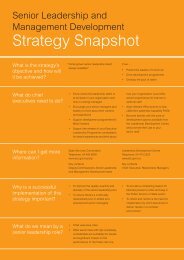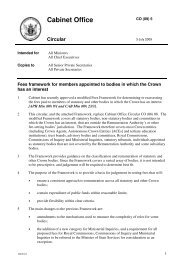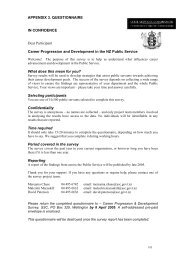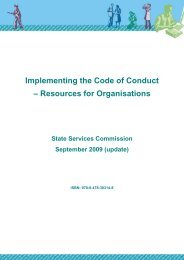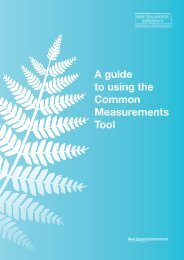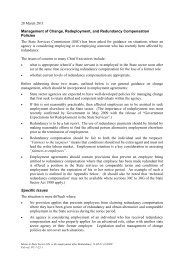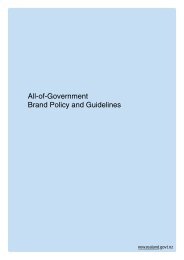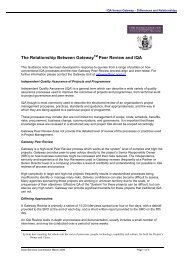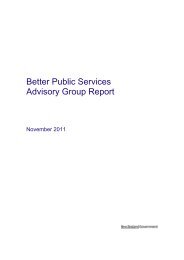NZ Report / Proposal Template - State Services Commission
NZ Report / Proposal Template - State Services Commission
NZ Report / Proposal Template - State Services Commission
Create successful ePaper yourself
Turn your PDF publications into a flip-book with our unique Google optimized e-Paper software.
5.54 This issue is not just a matter of good process for two main reasons. The first of<br />
these is that CWA potentially exposes the client to financial risk unless the CWA approach<br />
is well managed. To the extent that CWA was discussed with the Steering Group in the<br />
context of Northland, it is clear that the potential benefits of CWA were described. What<br />
is less clear is whether the risks and costs around CWA were explained along with the<br />
critical factors that must be achieved in order for a CWA to work well and in the client’s<br />
interests. The lack of paper trail makes this difficult to evaluate but our impression is that<br />
the benefits of CWA were emphasised to a much greater extent than the potential risks<br />
and costs involved.<br />
5.55 The second reason why the relative lack of consideration of procurement options<br />
is an issue is because prior to Northland, the Department had no knowledge or<br />
experience of alliancing. The need for rigorous consideration of this and other<br />
procurement options is even greater, the lesser is the knowledge and understanding of<br />
something new.<br />
5.56 These comments should not be interpreted as a criticism of the CWA<br />
methodology. Indeed, we note advice from the UK National Audit Office (NAO)<br />
recommending that departments not use traditional forms of procurement for construction<br />
projects unless it can be demonstrated that this form of procurement will provide better<br />
value for money ahead of design and build, or alliancing (the closest form of which is<br />
6<br />
described as “prime contracting” by the NAO) or PFI. Moreover, the comments should<br />
not be interpreted as saying that CWA was the wrong choice. In this regard, we note that<br />
the Auckland Women’s project appears to have been delivered on time and within budget.<br />
In the case of the Spring Hill and Otago projects, independent advice provided to the<br />
Department in October 2005 advised that the Department should not depart from the<br />
CWA path to another form of procurement unless as an absolute last resort (although this<br />
advice was tendered at the time when construction of Spring Hill and Otago was well<br />
underway). 7<br />
5.57 Notwithstanding these points, we consider that the choice of procurement<br />
approach for any given project should be made on a case-by-case basis. In this regard,<br />
there are several factors that need to be considered before choices regarding<br />
procurement method are made. Below, we set out some high-level characteristics that<br />
would tend to favour use of CWA in preference to traditional <strong>NZ</strong>S 3910 forms of<br />
procurement. CWA is more likely to be preferred when the following conditions are<br />
characteristics are present.<br />
• The best way of achieving desired outcomes, in terms of the choice of<br />
technologies and processes, is uncertain. In the context of the regional prisons,<br />
their design was markedly different to that which had gone before and reflected a<br />
desire for a different approach to the management of inmates. By implication,<br />
however, there was uncertainty around the details of design and how this would<br />
interface with operational requirements.<br />
• There is a high degree of complexity in design, construction, technology and/or<br />
development which cannot be satisfactorily scoped at project commencement.<br />
Complexity per se does not favour CWA over other forms of procurement, but<br />
6 National Audit Office (2005) “Improving Public <strong>Services</strong> Through Better Construction” , London,<br />
p23.<br />
7 Peter Waterhouse 31 October 2005 “<strong>Report</strong> to RPDP on Construction Costs and Alternative<br />
Procurement Strategies”<br />
Methodology and Processes: Design, Costing, Procurement and Scheduling 38




